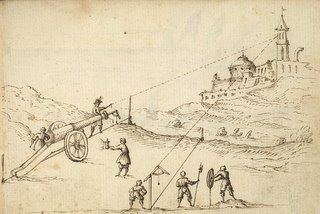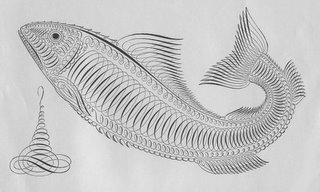Saturday, January 14, 2006
Sketch Bombing in the Mechanical Renaissance
This 17th century sketchbook of 600+ pages is written predominantly in italian with some spanish and is online at the Library of Congress. There are hundreds of illustrations, mostly in ink but with a few watercolours. There are perhaps 50+ blank pages and the text takes up about 1/4 of the remainder.
The book covers pyrotechnia, fortress styles, geometry, archimedes screw and hydaulic machinery, bomb construction, rope and pulley mechanisms, with apparent instructions and recipes for weaponry, elements of camouflage and advisory illustrations for hiding death traps thrown in for good measure.
The name Francesco Tensini (author of La Fortificatione, 1624) is mentioned twice.
That is unfortunately the extent of my knowledge about the work. Perhaps we should ask George if he knows anything more.
Friday, January 13, 2006
Etchings from the Waverley Novels
Sir Walter Scott (1771-1832) created and popularized the historic novel genre. In a 13 year period he published 8 novels anonymously wherein the characters' lives were sketched against the background of 18th century turmoils and violence in his Scottish homeland. He gave equally balanced treatment to peasants and kings and he modestly advocated for social change in a reflection of the age of enlightenment.
Scott had already established a reputation as a fine poet and it was likely his wish to preserve his good name that caused him to release the experimental Waverley book without a named author in 1814. Despite this it was hugely popular and over time the public began to suspect that Scott was responsible. He kept up the (by then) joke until he officially announced his authorship in 1827.
Waverley, Guy Mannering and The Antiquary form the backbone of the Waverley series and are the sources for the illustrations here. There are about 15 etchings in each book, completed by a wide selection of artists.
- Links to each of the illustrations are near the bottom of these table of contents pages at the University of Adelaide etext Library: Waverley; Guy Mannering; The Antiquary.
- The Walter Scott Digital Archive at Edinburgh University Library.
When first we practise to deceive!--
A Palmer too! No wonder why
I felt rebuked beneath his eye:
I might have known there was but one
Whose look could quell Lord Marmion.
[Marmion; A Tale of Flodden Field : Canto VI Stanza XVII]
Years ago a colleague of mine was generous enough to present me with a beautiful 1863 edition of Scott's Poetical Works which itself has 8 illustrations by Richard Corbould. I must admit I remember it better for the handwritten dedication inside than for the poetry...
"To Bluebeard
Oct 12th '65
A handful of good life
is better than a handful of learning"
Thursday, January 12, 2006
Emblemata Politica
"To the uninitiated, the emblem is indeed an esoteric artifact from the Early Modern Period. Its combinatory possibilites, however, associate it in many ways with the idea of the Renaissance individual - a person of many gifts and surprising talents whose charm consists of fresh new perspectives and engaging ideas. The emblem is very much the product of its age, combining texts and images in innovative ways for educational, devotional, entertainment, political and amorous purposes."

"The ideal emblem is typically described as a tripartite structure, comprised of motto (inscriptio), image (pictura), and epigram (subscriptio), and appeared in all European vernacular languages and latin. While emblems decorated secular and sacred architecture, objets d'art, and even everyday furniture and ephemeral art, such as triumphal arches for a monarch's entry, often emblems were published in books, and collections of emblems appearing in such volumes frequently, but not always, centred on a special theme or topos."
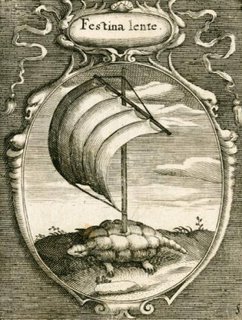
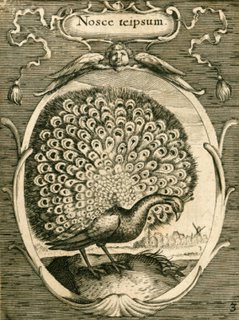
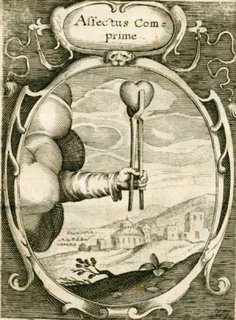
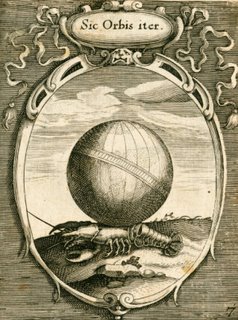 "The sense of this arcane image and its texts is something like that proverbial saying 'two steps forward, one step backward'. The reader must know something about natural history and that crayfish scuttle backwards. Thus, the crayfish, with the globe on its back symbolizes the way of the world, or sic orbis iter. The epigram [not shown] deepens the message and relates it to a moral lesson, admonishing the reader to avoid the slippery slope of worldly things and to follow the divine path."
"The sense of this arcane image and its texts is something like that proverbial saying 'two steps forward, one step backward'. The reader must know something about natural history and that crayfish scuttle backwards. Thus, the crayfish, with the globe on its back symbolizes the way of the world, or sic orbis iter. The epigram [not shown] deepens the message and relates it to a moral lesson, admonishing the reader to avoid the slippery slope of worldly things and to follow the divine path."

German printer, draftsman and engraver, Peter Is(s)elburg (1658-1630) was a significant artist from the Cologne and Nuremburg areas. He had a wide area of subject matter from lampoons and portraits to cityscapes, religious images and costumery. His legacy also included a large portfolio of emblemata.
- The images here come from Emblemata Politica In Aula Magna Curiae Noribergensis Depicta: quae sacra virtutum suggerunt monita, prudenter administrandi, fortiterque defendendi Rempublicam published in 1617, hosted at this University of Illinois Urbana-Champaign site. [this link works as at December 2012]
- There are 32 engravings in total and after I finished uploading these examples I found that Isselburg's work is also online at Herzog August Bibliothek Wolfenbüttel and the best way to see all the emblems together in thumbnail format is via this Menemosyne intermediary website (clicking through each image takes you to the original jpeg file at HAB-W : and these are arguably a better/clearer product and they are also a bit larger).
- For anyone keen, the above quotes were snagged from "Digital Collections and the Management of Knowledge: Renaissance Emblem Literature as a Case Study for the Digitization of Rare Texts and Images" comprising a dozen seminar topics that were attended by all the major emblemata hosting sites in the world in 2003.
- Previous emblem entries here at BibliOdyssey.
- See also: i; ii; iii; iv; v; vi; vii; viii; ix; x at Giornale Nuovo.
Wednesday, January 11, 2006
The Art of Penmanship
"Exercises are the most essential part of a penman's daily duties. No matter how expert the penman may be, he continues to rely upon practicing exercises to retain control...As the oval is the basis upon which the capitals are formed, the student should give the direct oval a half hour's practice each day.
The ovals should be made rapidly to count or to the music of a phonograph. In the use of a phonograph be sure the rhythm is such as can be followed. A march, one step or two step is best for exercise practice. Play rapidly and keep your motion in time with the rhythm.
If your lines are wavy, you are writing too slowly. If the lines vary in color, you are using the fingers. If your letters are not uniform, you are probably writing too rapidly."
The International Association of Master Penmen, Engrossers and Teachers of Handwriting have about 20 vintage writing books online - I only (dare I say) dipped my quill into a few today.
Turtle Diary





 Thomas Bell (1792-1880) was a dentist by trade but his interests were occupied by zoology. He was a founding member of the London Zoological Society, President of the Linnean Society, member of the Royal Society and Professor of Zoology at King's College London.
Thomas Bell (1792-1880) was a dentist by trade but his interests were occupied by zoology. He was a founding member of the London Zoological Society, President of the Linnean Society, member of the Royal Society and Professor of Zoology at King's College London.
He released a number of zoological publications but his great passion was for crustaceans. Darwin consigned to his care and study all crustacean specimens collected during the voyage of the Beagle.
So his intention of publishing a book outlining the sum of world knowledge about all the known species of turtle was somewhat outside his experience. The work was issued in 8 parts between 1832 and 1838 but a problem with the publisher left a quarter of it unreleased. (further text by John Gray would accompany the leftover original illustrations and the complete volume was issued 40 years later)
The importance of this book lays of course with the illustrations. James de Carle Sowerby had access to living specimens and painted 66 pictures which were made into lithographs by the great Edward Lear - the original publication contained 40 hand coloured plates and is considered to be the foremost collection of turtle illustrations ever released. The edition from which the above images derive includes 61 lithographic plates.
A Monograph of the Testudinata is online at the Octavo website - click on any of the images to launch the viewing browser and note the 'thumbnail' link at the top. (I thought the site wasn't working a while back when I neglected to allow pop-ups. Thanks for the tip misteraitch!)
Lancelot
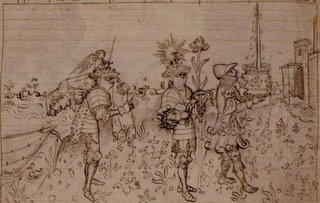

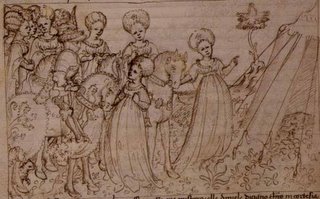


The legends associated with King Arthur, Sir Lancelot, the Knights of the Round Table, Merlin, the quest for the Holy Grail, the role of Lady Guinevere and the magical sword Excalibur, grew out of a number of literary sources in England and France from about the 11th century onwards.
The definitive version of these fictitious stories was Le Morte d'Arthur by Sir Thomas Malory, written in about 1470 - in time for the printing press of William Caxton to confer immortality onto the publication [1485]. The legendary motifs that persist today can be found in this version.
The images here are from a vellum manuscript in latin. There isn't any commentary and I have no idea whether or not it preceded Malory's work. If I had to lay money on it, I'd say it was written about the same time (or earlier as my 2nd guess). There are sketches on virturally every page: ~350 pages in total and they were done by probably 2 or 3 hands ranging from insipid to cartoon-like to Da Vinci-like. It's probable that the small amount of colouring of embellished letters and a couple of the sketches was added later. Some 30 or more pages are badly stained. But for the mostpart I thought it was an interesting work to flick through.
- La tavola rotonda, in volgare dialettale [essentially: 'The Round Table, in vulgate dialect'] (Manoscritto Palatino 556) is hosted by La Biblioteca Nazionale Centrale di Firenze.
- Putting 'King Arthur' or 'Sir Lancelot' into any search engine brings up a lot of results. I found the Arthurian Legend homesite to be easy to read, succinct and informative. They also have the wonderful 1940's Francoise Taylor engravings relating to the Arthurian story.
- Arthurian links from Dmoz and Voice of the Shuttle.
Tuesday, January 10, 2006
Folk Norway





This book of ~30 lithographs was released as 3 serial publications between 1854 and 1861. It was intended as a vehicle to showcase the Norwegian painting talents of Adolph Tidemand, Hans Fredrik Gude, Knud Larsen Bergslien and Johan Fredrik Eckersberg.
Norske Folkelivsbilleder is online at Bergen University in Norway.
The History of Medicine in Book Frontpieces
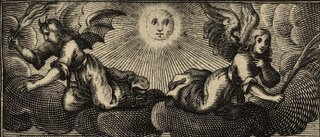 Nosodochium in quo cutis... affectus omnes...
Nosodochium in quo cutis... affectus omnes... et cognoscendi et curandi fidelissime traduntur
Samuel Hafenreffer 1660 (detail)
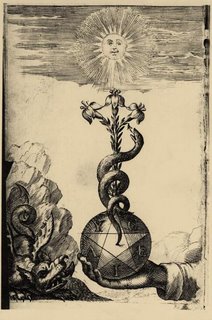 Le barbier médecin ou les Fleurs d’Hippocrate dans
Le barbier médecin ou les Fleurs d’Hippocrate dans lequel la chirurgie a repris la queue du serpent
Jean Michault 1672
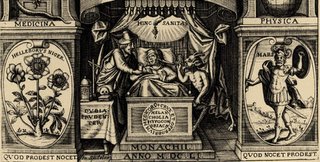 Microcosmus hypochondriacus sive de
Microcosmus hypochondriacus sive de melancholia hypochondriaca tractatus
Malachias Geiger 1652 (detail)
I found this image or at least the implied treatment most intriguing. It translates as 'Curing the paralysed with electricity'. It was written by an Abbott who worked as an experimental physicist at the University of Perpignan. As best as my limited brain can understand, sparks were somehow provoked between bulbs (I guess that's one of them top middle) and this form of apparatus is said to be found in medical history museums. I had never heard of this 'method of treatment' before.
100 Frontispieces de Livres de Médecine du 16e Siècle au Début de 19e Siècle is a fantastic exhibition (in french) of the opening images from treatises issued over 3 centuries, at the Bibliothèque Interuniversitaire de Médecine. It's a part-Flash site and all of the images are wonderfully large (although I couldn't get them to load from the index -- firefox on windows)
Even leaving aside the translation, I found the details in many of the images to be thorougly interesting -- it's possible to discern many weird and wonderful treatment modalities just by looking at the pictures. Everything from insane asylums to gardening to surgery and pharmacy.
[Some artifact has been erased - most particularly from library stamps! Oy.]
I've previously compiled a list of historical medical images online but I'm reasonably confident that I haven't seen the majority of images from the above exhibition.
-------------------
(And thanks very much to Cliopatria. I'm a bit shocked. But happy. Cheers!)





